View in other NatureServe Network Field Guides
NatureServe
Montana
Utah
Wyoming
Idaho
Wisconsin
British Columbia
South Carolina
Yukon
California
New York
Regal Fritillary - Argynnis idalia
Other Names:
Speyeria idalia
General Description
The following is taken from Ferris and Brown 1981, Scott 1986, Opler and Wright 1999, and Glassberg 2001. Regal Fritillary are large butterflies with a wing span of 6.5-10.5 mm (2.5-4.0 inches). Their front wing is orange with black spots and their hind wing is black with white spots. Their large size and distinctive coloration make them one of the most recognized butterflies in the east and central US.
Phenology
Males emerge before females in early summer (mid-June), they mate, and females lay eggs in the fall. Regal Fritillaries do not migrate, but females are nomadic in late summer (August). Larvae hibernate in prairies with stable resources (Swengel and Swengel 2016) from September to June (Kopper et al. 2001). Interestingly, females do not rely on the presence of their larval host plants, Violets (Viola spp.), to lay eggs. Regal Fritillaries have high fecundity and lay over 2000 eggs on the underside of leaves (Kopper et al. 2000) increasing the chance of some emergent caterpillars locating Violets by laying many eggs across scattered habitats.
Diagnostic Characteristics
Best determined by the large size, body is brownish-black, uppersurface of forewing reddish-orange with ornate black markings, hindwing is velvety black with a postmendian row of white spots and a submarginal row of whitish spots in female, orangish in male, undersurface of hindwing is dark brown with many elongate whitish spots.
Range Comments
Historically, the Regal Fritillary occupied much of the eastern United States and are considered prairie specialists (U.S. Fish and Wildlife Service 2013). They occurred along the east coast, from Maine to North Carolina, and extended westward to the eastern Wyoming and Montana (Selby 2007, Crawford and Tronstad 2020, Crawford 2022). Regal Fritillaries largely disappeared from the eastern portion of their range (Swengel et al. 2011) and Regal Fritillaries occur in eastern Wyoming (Crawford and Tronstad 2020, Crawford 2022). In Montana, documented in the late 19th century from Custer County (Kohler 1980, Stanford and Opler 1993).
Observations in Montana Natural Heritage Program Database
Number of Observations: 6
(Click on the following maps and charts to see full sized version)
Map Help and Descriptions
Relative Density
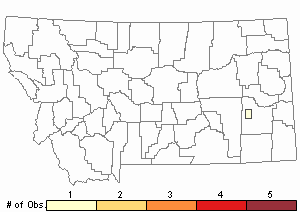
Recency
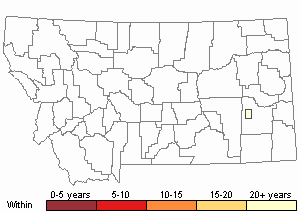
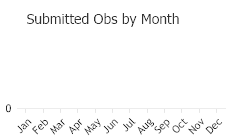
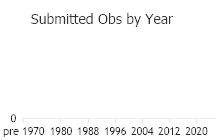
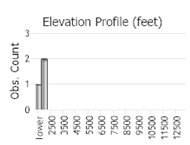 (Observations spanning multiple months or years are excluded from time charts)
(Observations spanning multiple months or years are excluded from time charts)
Migration
Non-migratory. Females are nomadic in late summer.
Habitat
Found in wet meadows, undisturbed prairie near marshes, dry to mesic tallgrass prairie, shortgrass prairie, and restored prairie (Ferris and Brown 1981, Scott 1986, Debinski and Babbit 1997, Swengel 1997, Opler and Wright 1999, and Glassberg 2001). These butterflies are primarily restricted to midgrass and tall-grass prairies of the central Great Plains (Scott 1986, Opler and Wright 199, Kopper et al. 2000, and Glassberg 2001). Violets (Viola spp.) are the host plant for Regal Fritillary butterflies. Adult Regal Fritillaries prefer high densities of forbs and a diversity of flowering plants (Caven et al. 2017), gravitating towards areas with recent fires because of increased flower production (Ehrenreich and Aikman 1963). These butterflies generally avoid areas with bare ground, instead preferring land with more litter and lower grazing intensities (Caven et al. 2017). Their habitat is predicted to shift north as air temperatures rise (Post van der Burg et al. 2023).
Food Habits
Larval food plants include several species of
Viola (Scott 1986, Swengel 1997). Adults feed on flower nectar, including
Apocynum, Asclepias, Calyophus, Carduus, Centaurea, Chrysanthemum, Cirsium,
Cornus,
Common Crown-vetch, (
Coronilla varia),
Dianthus,
Narrow-leaved Purple Coneflower< (
Echinacea),
Eryngium, Helianthus, Liatris, Lobelia, Medicago,
Beebalm, (
Monarda fistulosa),
Pycnanthemum, Rhus, Rubus, Rudbeckia, Salvia, Shrankia, Trifolium,
Fascicled Ironweed, (
Vernonia fasciculata ssp. Corymbose), and
Veronica (Kopper et al. 2001a, Tooker et al. 2002, and Scott 2014).
Reproductive Characteristics
Females lay eggs singly in shaded sites of grass and forbs near the ground, usually on the undersides of dead vegetation, often near larval food plant but never on it. Larvae build no nests. They overwinter (hibernate) as L1 instars (Scott 1986, and Kopper et al. 2000, 2001a). Males patrol low (10-50 cm) above the ground for distances of 5-30 m throughout the day in search of females, circling back 1-2 m above ground and repeating the low upwind flight. Both sexes take the role of flight while copulating. Females mate once, experience a post-mating reproductive diapause before initiating egg-laying (Scott 1986, Kopper et al. 2001a, 2001b).
Management
Regal Fritillary butterflies were petitioned for Endangered Species Act listing on 19 April 2013.On August 6th, 2024 the US Fish and Wildlife Service proposed listing the western subspecies (
A. i. occidentalis ) as Threatened under the Endangered Species Act. Additional information on the species' management can be found on the U.S. Fish and Wildlife Service's
Species Account.
Stewardship Responsibility
References
- Literature Cited AboveLegend:
 View Online Publication
View Online Publication Caven, A.J., K.C. King, J.D. Wiese, E.M. Brinley Buckley. 2017. A descriptive analysis of regal fritillary (Speyeria idalia) habitat utilizing biological monitoring data along the big bend of the Platte River, NE. Nebraska Cooperative Fish & Wildlife Research Unit, Staff Publications 236. 24 p.
Caven, A.J., K.C. King, J.D. Wiese, E.M. Brinley Buckley. 2017. A descriptive analysis of regal fritillary (Speyeria idalia) habitat utilizing biological monitoring data along the big bend of the Platte River, NE. Nebraska Cooperative Fish & Wildlife Research Unit, Staff Publications 236. 24 p. Crawford, C. 2022. Rare plant and butterfly monitoring in eastern Wyoming: the pollination mechanisms of Laramie chickensage (Artemisia simplex), and the status and distribution of regal frittillary (Argynnis idalia) and Monarch (Danaus plexippus). Laramie, WY: University of Wyoming.
Crawford, C. 2022. Rare plant and butterfly monitoring in eastern Wyoming: the pollination mechanisms of Laramie chickensage (Artemisia simplex), and the status and distribution of regal frittillary (Argynnis idalia) and Monarch (Danaus plexippus). Laramie, WY: University of Wyoming. Crawford, M.S. and L. Tronstad. 2020. The status and distribution of regal fritillary (Speyeria idalia) and monarch (Danaus plexippus) butterflies in eastern Wyoming. Report prepared by the WYNDD, University of Wyoming for the WY Governor's office. 23 p.
Crawford, M.S. and L. Tronstad. 2020. The status and distribution of regal fritillary (Speyeria idalia) and monarch (Danaus plexippus) butterflies in eastern Wyoming. Report prepared by the WYNDD, University of Wyoming for the WY Governor's office. 23 p. Debinski, D.M. and A.M. Babbit. 1997. Butterfly species in native prairie and restored prairie. Prairie Naturalist 29:219-227.
Debinski, D.M. and A.M. Babbit. 1997. Butterfly species in native prairie and restored prairie. Prairie Naturalist 29:219-227. Ehrenreich, J.H. and J.M. Aikman. 1963. An ecological study of the effect on certain management practices on native prairie in Iowa. Ecological Monographs, 33(2): 113-130.
Ehrenreich, J.H. and J.M. Aikman. 1963. An ecological study of the effect on certain management practices on native prairie in Iowa. Ecological Monographs, 33(2): 113-130. Ferris, C.D. and F.M. Brown (eds). 1981. Butterflies of the Rocky Mountains. Univ. of Oklahoma Press. Norman. 442 pp.
Ferris, C.D. and F.M. Brown (eds). 1981. Butterflies of the Rocky Mountains. Univ. of Oklahoma Press. Norman. 442 pp. Glassberg, J. 2001. Butterflies through Binoculars: A Field Guide to the Butterflies of Western North America. Oxford University Press.
Glassberg, J. 2001. Butterflies through Binoculars: A Field Guide to the Butterflies of Western North America. Oxford University Press. Kohler, S. 1980. Checklist of Montana Butterflies (Rhopalocera). Journal of the Lepidopterists' Society 34(1): 1-19.
Kohler, S. 1980. Checklist of Montana Butterflies (Rhopalocera). Journal of the Lepidopterists' Society 34(1): 1-19. Kopper, B.J., D.C. Margolies, and R.E. Charlton. 2001a. Life history notes on the Regal Fritillary, Speyeria idalia (Drury) (Lepidoptera: Nymphalidae), in Kansas tallgrass prairie. Journal of the Kansas Entomological Society 74(3): 172-177.
Kopper, B.J., D.C. Margolies, and R.E. Charlton. 2001a. Life history notes on the Regal Fritillary, Speyeria idalia (Drury) (Lepidoptera: Nymphalidae), in Kansas tallgrass prairie. Journal of the Kansas Entomological Society 74(3): 172-177. Kopper, B.J., R.E. Charlton, and D.C.Margolies. 2000. Oviposition site selection by the Regal Fritillary, Speyeria idalia, as affected by proximity to violet host plants. Journal of Insect Conservation 13(5): 651-665.
Kopper, B.J., R.E. Charlton, and D.C.Margolies. 2000. Oviposition site selection by the Regal Fritillary, Speyeria idalia, as affected by proximity to violet host plants. Journal of Insect Conservation 13(5): 651-665. Kopper, B.J., S. Shu, R.E. Charlton, and S.B. Ramaswamy. 2001b. Evidence for reproductive diapause in the fritillary Speyeria idalia (Lepidoptera: Nymphalidae). Annals of the Entomological Society of America 94(3): 427-432.
Kopper, B.J., S. Shu, R.E. Charlton, and S.B. Ramaswamy. 2001b. Evidence for reproductive diapause in the fritillary Speyeria idalia (Lepidoptera: Nymphalidae). Annals of the Entomological Society of America 94(3): 427-432. Opler, P.A. and A.B. Wright. 1999. A field guide to western butterflies. Second edition. Peterson Field Guides. Houghton Mifflin Company, Boston, Massachusetts. 540 pp.
Opler, P.A. and A.B. Wright. 1999. A field guide to western butterflies. Second edition. Peterson Field Guides. Houghton Mifflin Company, Boston, Massachusetts. 540 pp. Post van der Burg, M., G. MacDonald, T. Hefley, J. Glassberg. 2023. Point-scale habitat and weather patterns influence the distribution of regal fritillaries in the central United States. Ecosphere 14(3):1-15.
Post van der Burg, M., G. MacDonald, T. Hefley, J. Glassberg. 2023. Point-scale habitat and weather patterns influence the distribution of regal fritillaries in the central United States. Ecosphere 14(3):1-15. Scott, J.A. 1986. The butterflies of North America: a natural history and field guide. Stanford University Press, Stanford, California.
Scott, J.A. 1986. The butterflies of North America: a natural history and field guide. Stanford University Press, Stanford, California. Scott, J.A. 2014. Lepidoptera of North America 13. Flower visitation by Colorado butterflies (40,615 records) with a review of the literature on pollination of Colorado plants and butterfly attraction (Lepidoptera: Hersperioidea and Papilionoidea). Contributions of the C.P. Gillette Museum of Arthopod Diversity. Fort Collins, CO: Colorado State University. 190 p.
Scott, J.A. 2014. Lepidoptera of North America 13. Flower visitation by Colorado butterflies (40,615 records) with a review of the literature on pollination of Colorado plants and butterfly attraction (Lepidoptera: Hersperioidea and Papilionoidea). Contributions of the C.P. Gillette Museum of Arthopod Diversity. Fort Collins, CO: Colorado State University. 190 p. Selby, G. 2007. Regal fritillary (Speyeria idalia Drury): a technical conservation assessment. USDA Forest Service, Rocky Mountain Region. 53 p.
Selby, G. 2007. Regal fritillary (Speyeria idalia Drury): a technical conservation assessment. USDA Forest Service, Rocky Mountain Region. 53 p. Stanford, R.E. and P.A. Opler. 1993. Atlas of western USA butterflies: including adjacent parts of Canada and Mexico. Unpubl. Report. Denver and Fort Collins, Colorado 275 pp.
Stanford, R.E. and P.A. Opler. 1993. Atlas of western USA butterflies: including adjacent parts of Canada and Mexico. Unpubl. Report. Denver and Fort Collins, Colorado 275 pp. Swengel, A.B. 1997. Habitat associations of sympatric violet-eating fritillaries (Euptoeita, Speyeria, Boloria)(Lepidoptera: Nymphalidae) in tallgrass prairie. Great lakes Entomologist 30(1/2): 1-18.
Swengel, A.B. 1997. Habitat associations of sympatric violet-eating fritillaries (Euptoeita, Speyeria, Boloria)(Lepidoptera: Nymphalidae) in tallgrass prairie. Great lakes Entomologist 30(1/2): 1-18. Swengel, S.R. and A.B. Swengel. 2016. Status and trend of regal fritillary (Speyeria idalia) (Lepidoptera: Nymphalidae) in the 4th of July butterfly count program in 1977-2014. Scientifica 2016:1-10.
Swengel, S.R. and A.B. Swengel. 2016. Status and trend of regal fritillary (Speyeria idalia) (Lepidoptera: Nymphalidae) in the 4th of July butterfly count program in 1977-2014. Scientifica 2016:1-10. Swengel,S.R., D. Schlicht, F. Olsen, A. Swengel. 2011. Declines of prairie butterflies in the midwestern USA. Journal of Insect Conservation 15:327-339.
Swengel,S.R., D. Schlicht, F. Olsen, A. Swengel. 2011. Declines of prairie butterflies in the midwestern USA. Journal of Insect Conservation 15:327-339. Tooker, J.F., P.F. Reagel, and L.M. Hanks. 2002. Nectar sources of day-flying lepidoptera of central Illinois. Annals of the Entomological Society of America 95(1): 84-96.
Tooker, J.F., P.F. Reagel, and L.M. Hanks. 2002. Nectar sources of day-flying lepidoptera of central Illinois. Annals of the Entomological Society of America 95(1): 84-96. U.S. Fish and Wildlife Service. 2013. Species assessment for regal fritillary.
U.S. Fish and Wildlife Service. 2013. Species assessment for regal fritillary.
- Additional ReferencesLegend:
 View Online Publication
View Online Publication
Do you know of a citation we're missing? Allen, T.J., J.P. Brock, and J. Glassberg. 2005. Caterpillars in the field and garden: a field guide to the butterfly caterpillars of North America. Oxford University Press.
Allen, T.J., J.P. Brock, and J. Glassberg. 2005. Caterpillars in the field and garden: a field guide to the butterfly caterpillars of North America. Oxford University Press. Brock, J.P. and K. Kaufman. 2003. Kaufman Field Guide to Butterflies of North America. Houghton Mifflin Company, New York, NY 284 pp.
Brock, J.P. and K. Kaufman. 2003. Kaufman Field Guide to Butterflies of North America. Houghton Mifflin Company, New York, NY 284 pp. Layberry, R.A., P.W. Hall, and J.D. LaFontaine. 1998. The Butterflies of Canada. University of Toronto Press. 280 pp. + color plates.
Layberry, R.A., P.W. Hall, and J.D. LaFontaine. 1998. The Butterflies of Canada. University of Toronto Press. 280 pp. + color plates. Opler, P.A. and A.D. Warren. 2002. Scientific names list for butterfly species of North America, north of Mexico. C.P Gillette Museum of Arthropod Diversity, Department of Bioagricultural Sciences and Pest Management, Colorado State University, Fort Collins, Colorado. 79 pp.
Opler, P.A. and A.D. Warren. 2002. Scientific names list for butterfly species of North America, north of Mexico. C.P Gillette Museum of Arthropod Diversity, Department of Bioagricultural Sciences and Pest Management, Colorado State University, Fort Collins, Colorado. 79 pp. Scott, J.A. 1979. Hibernal diapause of North American Papilionoidea and Hesperioidea. Journal of Research on the Lepidoptera 18(3): 171-200.
Scott, J.A. 1979. Hibernal diapause of North American Papilionoidea and Hesperioidea. Journal of Research on the Lepidoptera 18(3): 171-200.
- Web Search Engines for Articles on "Regal Fritillary"
- Additional Sources of Information Related to "Insects"





